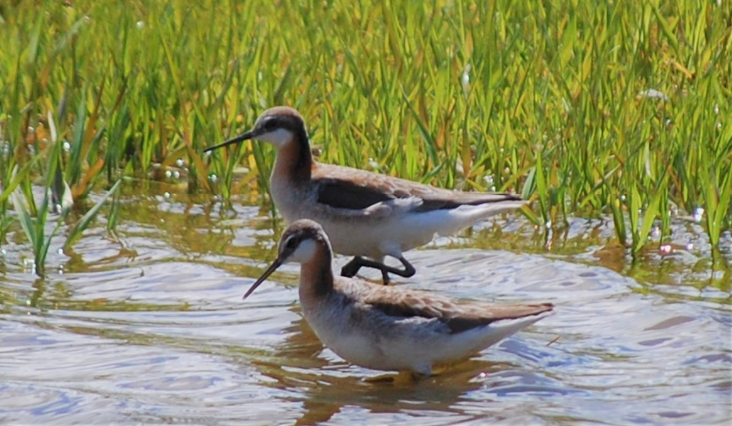Ken Schopp

Wilson's Phalaropes, Ashley Falls. Photograph by Ken Schopp.
I participated in Mass Audubon's Bird-a-thon for Berkshire County on May 16, 2020. Special rules were in place this year whereby you had to walk or bicycle to your destinations. I started out early and observed some pretty good birds but did this walking. At 10:00 am, I decided to bicycle and went into the shed to get my bike but it had a flat tire. I called my friend Jim Bennett and asked to borrow his bike. .
Jim lives about .75 mile from me. It was a beautiful day, so I grabbed my binoculars and walked down the railroad tracks to pick up his bike, birding on the way. The tracks border Howden Farm and always provide good birding opportunities. Jim and his wife Robin own several hundred acres of beautiful Housatonic River bottomland and Jim lets me fish, bird, and hunt wildfowl on his property. I arrived at 10:15 and decided to check a partially flooded pasture just south of Jim's house, west of the Housatonic River, and adjacent to Route 7A in Ashley Falls. This has become a very popular birding venue because of the easy access and the visibility from Route 7A. On eBird, it is referred to as the Route 7A Hole, Sheffield. I don't particularly care for that moniker, so I always post my observations there as Bennett's Farm.
This flooded area covered roughly one acre in a freshly planted field of about 50 acres. Every year in the spring when it is flooded, it attracts rare birds such as Glossy Ibis, Sandhill Crane, and, a number of years ago, White Ibis. My initial observation produced about 15 Least Sandpipers and eight Solitary Sandpipers, all foraging in a mud puddle in the flooded pasture. I spotted the two Wilson's Phalaropes wading in the puddle foraging and knew right away they were phalaropes. The phalaropes stayed in the shallow water the entire time, whereas the other shorebirds waded in and out of the large puddle and into the short grass. Both phalaropes were females in breeding plumage.
Fortunately, I had my cell phone with me. My first phone call was to my wife Becky to drive down and bring my camera which she did promptly. Next, I called area birders. Greg Ward, Rene Wendell, Gael Hurley, and Jonathan Pierce dropped what they were doing and drove down from Pittsfield to check out these two phalaropes. They are Berkshire County's all-stars of birding and they got to see the birds. I stayed and observed the two phalaropes for 45 minutes. Most unfortunately, Jim's young son decided to do some rifle-shooting practice behind the barn. This was not malicious, just an unfortunate coincidence and all the birds flushed on the sound of the first shot. Six more birders showed up but the phalaropes did not return. I checked again late in the day and early the next morning, but no phalaropes.
Wilson's Phalarope is accidental in Berkshire County. My May 16 sighting is only the second report of this species in Ashley Falls since May 1977, when three females were spotted in a puddle (St. James 2012). It is the fifth record for all of Berkshire County. The first Wilson's Phalarope in the county was found in Pittsfield on May 16, 1933; there are two more reports from Pittsfield in June 1972 and September 1974 (St. James 2012).
I started keeping written journals of bird observations in 1967 when I was 11. Now I use eBird. The journals comprise observations of birds at our family bird feeder and adjacent woods. The journals themselves were simply sheets of lined paper folded in half and stapled with the time period written on the cover. I still have some of them in my possession and have randomly entered checklists from these written journals into eBird. My oldest eBird checklist dates from 1969 and all my pre-1980 eBird checklists are based on observations where I grew up in Claverack, New York. This hamlet is just east of Hudson, New York, in Columbia County.
Reference